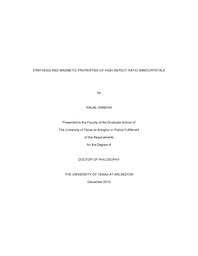
ATTENTION: The works hosted here are being migrated to a new repository that will consolidate resources, improve discoverability, and better show UTA's research impact on the global community. We will update authors as the migration progresses. Please see MavMatrix for more information.
Show simple item record
| dc.contributor.advisor | Liu, J. Ping | |
| dc.creator | Gandha, Kinjal | |
| dc.date.accessioned | 2017-03-23T15:03:19Z | |
| dc.date.available | 2017-03-23T15:03:19Z | |
| dc.date.created | 2015-12 | |
| dc.date.issued | 2015-12-07 | |
| dc.date.submitted | December 2015 | |
| dc.identifier.uri | http://hdl.handle.net/10106/26510 | |
| dc.description.abstract | The aim of this thesis is to synthesize and investigate the structural and magnetic properties of anisotropic nanostructures in particular, nanowires and nanorods of Fe, Co, and bimetallic systems (FeCo, CoNi) and ferrites (CoFe2O4, Fe3O4) that have potential applications in rare-earth-free magnets, biomedical materials and magnetic recording devices. Anisotropic nanostructures with high aspect ratio were synthesized via bottom-up approach using chemical solution methods. The size and shape of the nanostructures were found to be dependent on experimental parameters such as the catalyst concentration, the surfactant ratio, the precursor concentration and the heating rate. It was observed that the uniformity in morphology, structure and composition of the nanowires was the key to achieving a high coercivity. In case of bcc Fe and FeCo nanowires, coercivity is mostly determined by shape anisotropy that results in moderate coercivity. On other hand, Co and CoNi nanowires with hcp crystallographic structure give extraordinarily high magnetic hardening, especially when the wires are aligned. Record high coercivity up to 12.5 kOe has been achieved in our experiments (corresponding to an energy product of >40 MGOe if full density is counted) which is significantly higher than any Co-based bulk or thin film materials reported to date. It has been found that the shape anisotropy plays an essential role in the magnetic hardening when the wire’s long axis is along the c-axis of the hcp crystals.
We also present in this study the structural and magnetic properties of high aspect ratio Co nanowires at high temperatures (up to 650 K) using PPMS characterizations. We show that the anisotropic shapes, the structural and texture properties are preserved up to 500K.
The magnetization reversal process in the single-crystalline nanowires was also investigated by measuring the angular dependence of the coercivity and comparing with the Stoner-Wohlfarth model. It was observed that the magnetization reversal in Co nanowires is proceeded via a coherent rotation process. In addition, surface oxidized Co nanowires have provided us a unique opportunity to study the exchange bias in the aligned Co/CoO core-shell nanostructures. Study of temperature and angular dependence of the exchange bias field and the coercive field in the Co/CoO core-shell nanowires underlines the importance of the interplay of the different magnetic anisotropy at the interface. Ferromagnetic nanowires of this type are ideal building blocks for future bonded, consolidated and thin film magnets with high energy density and high thermal stability. | |
| dc.format.mimetype | application/pdf | |
| dc.language.iso | en_US | |
| dc.subject | Nanowires | |
| dc.subject | Nanorods | |
| dc.subject | High aspect ratio | |
| dc.subject | Ferromagnetic | |
| dc.subject | Antiferromagnetic | |
| dc.subject | Core-shell nanowires | |
| dc.subject | Exchange-bias | |
| dc.subject | Magnetic materials | |
| dc.subject | Chemical synthesis | |
| dc.subject | Solvothermal synthesis | |
| dc.subject | Hydrothermal synthesis | |
| dc.subject | Polyol synthesis | |
| dc.title | SYNTHESIS AND MAGNETIC PROPERTIES OF HIGH-ASPECT-RATIO NANOCRYSTALS | |
| dc.type | Thesis | |
| dc.date.updated | 2017-03-23T15:03:19Z | |
| thesis.degree.department | Physics | |
| thesis.degree.grantor | The University of Texas at Arlington | |
| thesis.degree.level | Doctoral | |
| thesis.degree.name | Doctor of Philosophy in Physics and Applied Physics | |
| dc.type.material | text | |
Files in this item
- Name:
- GANDHA-DISSERTATION-2015.pdf
- Size:
- 9.596Mb
- Format:
- PDF
This item appears in the following Collection(s)
Show simple item record


